
WWW.SparkLAN.com
User’s Guide
0
Wireless 802.11g AP Router
WX-6615
User’s Guide
Version 1.0

WWW.SparkLAN.com
User’s Guide
1
Copyright statement
No part of this publication may be reproduced, stored in a retrieval system, or transmitted in any form
or by any means, whether electronic, mechanical, photocopying, recording, or otherwise without the
prior writing of the publisher.
March. 2003

WWW.SparkLAN.com
User’s Guide
2
.Contents
1. Introduction.................................................................................................................... 3
2. Safety Notification......................................................................................................... 4
3. Hardware Installation.................................................................................................... 5
4 Web Management Settings........................................................................................... 6
4.1. Setup……………………………………………………………………………………………………….7
4.2. Security…………………………………………………………………………………………………..10
4.3. System……………………………………………………………………………………………………12
4.4. DHCP……………………………………………………………………………………………………..15
4.5. SNMP……………………………………………………………………………………………………..17
4.6. Status……………………………………………………………………………………………………..18
4.7. Advanced Wireless…………………………………………………………………………………...19
4.8. Filters……………………………………………………………………………………………………..22
4.9. Port Forwarding……………………………………………………………………………………….25
4.10. Routing…………………………………………………………………………………………………27
4.11. DDNS…………………………………………………………………………………………………..29
5. Troubleshooting..........................................................................................................30

WWW.SparkLAN.com
User’s Guide
3
1. Introduction
Thank you for purchasing your WX-6615 Wireless 802.11g AP Router.
This user guide will assist you with the installation procedure.
The package you have received should contain the following items:
§ WX-6615 Wireless 802.11g AP Router
§ User Guide
§ Power Supply / Cord
§ Ethernet Cable
Note: if anything is missing, please contact your vendor

WWW.SparkLAN.com
User’s Guide
4
2. Safety Notification
Your Wireless AP Router should be placed in a safe and secure location. To ensure proper operation,
please keep the unit away from water and other damaging elements. Please read the user manual
thoroughly before you install the device. The device should only be repaired by authorized and
qualified personnel.
§ Please do not try to open or repair the device yourself.
§ Do not place the device in a damp or humid location, i.e. a bathroom.
§ The device should be placed in a sheltered and non-slip location within a temperature range of
+5 to +40 Celsius degree.
§ Please do not expose the device to direct sunlight or other heat sources. The housing and
electronic components may be damaged by direct sunlight or heat sources.

WWW.SparkLAN.com
User’s Guide
5
3. Hardware Installation
Front Panel
The front panel provides LED’s for device status. Refer to the following table for the meaning of each
feature.
Rear Panel
The rear panel features 4 LAN ports, 1 WAN port and Reset button. Refer to the following table for the
meaning of each feature.
WX-6615 AP Router Default Settings
The default settings are shown following.

WWW.SparkLAN.com
User’s Guide
6
4 Web Management Settings
START UP & LOGIN
In order to configure the Wireless 11g AP Router, you must use your web browser and manually input
http://192.168.1.1 into the Address box and press Enter. The Main Page will appear.
In order to configure the Wireless 11g AP Router, you must input the password into the Password box
and leave blank on the User Name box. The default password is “admin”.
Once you have logged-in as administrator, it is a good idea to change the administrator password to
ensure a secure protection to the Wireless 11g AP Router. The Security Settings section described
later in this manual describes how to change the password.
Once you have input the correct password and logged-in, the screen will change to the Setup page
screen.
TURN ON POWER SUPPLY
Quick power cycle can caused system corruption. When power on, be careful not to shut down in
about 5 seconds, because data is writing to the flash.

WWW.SparkLAN.com
User’s Guide
7
4.1. Setup
Setup
This screen contains all of the Router's basic setup functions.
.
Most users will be able to configure the AP Router and get it working properly using the settings on
this screen. Some Internet Service Providers (ISPs) will require that you enter WX-6615 Wireless
802.11g AP Router specific information, such as User Name, Password, IP Address, Default Gateway
Address, or DNS IP Address. This information can be obtained from your ISP, if required.
Internet:
Host Name: This entry is necessary for some ISPs and can be provided by them.
Domain Name: This entry is necessary for some ISPs and can be provided by them.
Configuration Type: The Router supports four connection types:
MAKE CORRECT NETWORK SETTINGS OF YOUR COMPUTER
To change the configuration, use Internet Explorer (IE) or Netscape Communicator to connect the
WEB management 192.168.1.1.

WWW.SparkLAN.com
User’s Guide
8
Automatic Configuration - DHCP
Static IP
PPPoE (Point-to-Point Protocol over Ethernet)
PPTP (Point-to-Point Tunneling Protocol)
These types can be selected from the drop-down menu next to Internet Connection. The information
required and available features will differ depending on what kind of connection type you select.
Some descriptions of this information are included here:
Internet IP Address and Subnet Mask
This is the Router's IP Address and Subnet Mask as seen by external users on the
Internet (including your ISP). If your Internet connection requires a static IP address,
then your ISP will provide you with a Static IP Address and Subnet Mask.
• Default Gateway
Your ISP will provide you with the Gateway IP Address.
• DNS (Domain Name Server) IP Address
Your ISP will provide you with at least one DNS IP Address.
• User Name and Password
Enter the User Name and Password you use when logging onto your ISP through a
PPPoE or PPTP connection.
• Connect on Demand
You can configure the Router to disconnect your Internet connection after a specified
period of inactivity (Max Idle Time). If your Internet connection has been terminated due
to inactivity, Connect on Demand enables the Router to automatically re-establish your
connection as soon as you attempt to access the Internet again. If you wish to activate
Connect on Demand, click the radio button.
If you want your Internet connection to remain active at all times, enter 0 in the WX-6615
802.11g AP Router max Idle Time field. Otherwise, enter the number of minutes you
want to have elapsed before your Internet connection terminates.
• Keep Alive Option
This option keeps you connected to the Internet indefinitely, even when your connection
sits idle. To use this option, click the radio button next to Keep Alive. The default Redial
Period is 30 seconds (in other words, the Router will check the Internet connection every
30 seconds).

WWW.SparkLAN.com
User’s Guide
9
LAN IP Address and Subnet Mask: This is the Router's IP Address and Subnet Mask as seen on
the internal LAN. The default value is 192.168.1.1 for IP Address and 255.255.255.0 for Subnet Mask.
Wireless: This section provide the Wireless Network settings for your WLAN
2.4GHz Settings
SSID: The service set identifier ( SSID ) or network name. It is case sensitive and must not exceed 32
characters, which may be any keyboard character. You shall have selected the same SSID for all the
APs that will be communicating with mobile wireless stations.
Domain: Please select the correct Domain for your physical location. European countries differ from
American region.
Channel: Select the appropriate channel from the list provided to correspond with your network
settings. You shall assign a different channel for each AP to avoid signal interference.
WEP: Make sure that all wireless devices on your network are using the same encryption level and
key. WEP keys must consist of the letters "A" through "F" and the numbers "0" through "9."
* Click Apply to save your settings.

WWW.SparkLAN.com
User’s Guide
10
4.2. Security
Router Password: Changing the password for the AP Router is as easy as typing the password into
the Enter New Password field. Then, type it again into the Re-enter to confirm.
* Click the Apply button to save the setting.
Use the default password when you first open the configuration pages, after you have configured
these settings, you should set a new password for the Router (using the Security screen). This will
increase security, protecting the Router from unauthorized changes.
VPN Pass-Through: Virtual Private Networking (VPN) is typically used for work-related networking.
For VPN tunnels, the Router supports IPSec Pass-Through, L2TP Pass-Through, and PPTP Pass-
Through.
• IPSec - Internet Protocol Security (IPSec) is a suite of protocols used to implement secure
exchange of packets at the IP layer. To allow IPSec tunnels to pass through the Router, IPSec
Pass-Through is enabled by default. To disable IPSec Pass-Through, uncheck the box next to
IPSec.
• L2TP - Layer 2 Tunneling Protocol is a protocol used to tunnel Point-to-Point Protocol (PPP)
over the Internet. To allow L2TP tunnels to pass through the Router, L2TP Pass-Through is
enabled by default. To disable L2TP Pass-Through, uncheck the box next to L2TP.
• PPTP - Point-to-Point Tunneling Protocol is the method used to enable VPN sessions to a
Windows NT 4.0 or 2000 server. To allow PPTP tunnels to pass through the Router, PPTP
Pass-Through is enabled by default. To disable PPTP Pass-Through, uncheck the box next to
PPTP.
Web Filters: Using the Web Filters feature, you may enable up to four different filters.

WWW.SparkLAN.com
User’s Guide
11
• Proxy - Use of WAN proxy servers may compromise network security. Denying Proxy will
disable access to any WAN proxy servers. To enable proxy filtering, click the box next to Proxy.
• Java - Java is a programming language for websites. If you deny Java, you run the risk of not
having access to Internet sites created using this programming language. To enable Java
filtering, click the box next to Java.
• ActiveX - ActiveX is a programming language for websites. If you deny ActiveX, you run the
risk of not having access to Internet sites created using this programming language. To enable
ActiveX filtering, click the box next to ActiveX.
• Cookies - A cookie is data stored on your PC and used by Internet sites when you interact with
them. To enable cookie filtering, click the box next to Cookies.
DMZ: The DMZ hosting feature allows one local user to be exposed to the Internet for use of a
special-purpose service such as Internet gaming or videoconferencing. DMZ hosting forwards all the
ports at the same time to one PC. The Port Forwarding feature is more secure because it only opens
the ports you want to have opened, while DMZ hosting opens all the ports of one computer, exposing
the computer so the Internet can see it.
Any PC whose port is being forwarded must have its DHCP client function disabled and should have a
new static IP address assigned to it because its IP address may change when using the DHCP
function.
1. To expose one PC, select Enable.
2. Enter the computer's IP address in the DMZ Host IP Address field.
3. Click the Apply button.
Block WAN Request: By enabling the Block WAN Request feature, you can prevent your network
from being "pinged," or detected, by other Internet users. The Block WAN Request feature also
reinforces your network security by hiding your network ports. Both functions of the Block WAN
Request feature make it more difficult for outside users to work their way into your network. This
feature is enabled by default. Select Disable to disable this feature.
* Check all the settings and click Apply to save them.

WWW.SparkLAN.com
User’s Guide
12
4.3. System
Restore Factory Defaults: Click the Yes button to reset all configuration settings to factory default
values. Note: Any settings you have saved will be lost when the default settings are restored. Click the
No button to disable the Restore Factory Defaults feature.
*Click the Apply button to save the setting.
Firmware Upgrade: Click the Upgrade button to load new firmware onto the Router. New firmware
versions are posted at www.sparklan.com and can be downloaded for free. If the Router is not
experiencing difficulties, then there is no need to download a more recent firmware version, unless
that version has a new feature that you want to use.
Note: When you upgrade the Router's firmware, you may lose its configuration settings, so
make sure you write down the Router’s settings before you upgrade its firmware.
To upgrade the Router's firmware:
1. Download the firmware upgrade file from the Sparklan website.
2. Extract the firmware upgrade file.
3. Click the Upgrade button.

WWW.SparkLAN.com
User’s Guide
13
4. On the Firmware Upgrade screen, click the Browse button to find the firmware upgrade file.
5. Double-click the firmware upgrade file.
6. Click the Upgrade button, and follow the on-screen instructions.
Note: Do not power off the Router or press the Reset button while the firmware is being
upgraded.
Multicast Pass-Through: IP Multicasting occurs when a single data transmission is sent to multiple
recipients at the same time. Using the Multicast Pass-Through feature, the Router allows IP multicast
packets to be forwarded to the appropriate computers. Keep the default setting, Enable, to support the
feature, or select Disable to disable it.
MAC Cloning: The Router's MAC address is a 12-digit code assigned to a unique piece of hardware
for identification. Some ISPs require that you register the MAC address of your network card/adapter,
which was connected to your cable or DSL modem during installation. If your ISP requires MAC
address registration, find your adapter’s MAC address by following the instructions for your PC’s
operating system.
For Windows 98 and Millennium:
1. Click the Start button, and select Run.
2. Type winipcfg in the field provided, and press the OK key.
3. Select the Ethernet adapter you are using.
4. Click More Info.
5. Write down your adapter's MAC address.
For Windows 2000 and XP:
1. Click the Start button, and select Run.
2. Type cmd in the field provided, and press the OK key.
3. At the command prompt, run ipconfig /all, and look at your adapter’s physical address.
4. Write down your adapter's MAC address.

WWW.SparkLAN.com
User’s Guide
14
To clone your network adapter's MAC address onto the Router and avoid calling your ISP to change
the registered MAC address, follow these instructions:
1. Select Enable.
2. Enter your adapter's MAC address in the MAC Address field.
3. Click the Apply button.
To disable MAC address cloning, keep the default setting, Disable.
Remote Management: This feature allows you to manage your Router from a remote location, via the
Internet. To disable this feature, keep the default setting, Disable. To enable this feature, select
Enable, and use the specified port (default is 8080) on your PC to remotely manage the Router. You
must also change the Router’s default password to one of your own, if you haven't already. A unique
password will increase security.
To remotely manage the Router, enter http://xxx.xxx.xxx.xxx:8080 (the x's represent the Router's
Internet IP address, and 8080 represents the specified port) in your web browser's Address field. You
will be asked for the Router's password. After successfully entering the password, you will be able to
access the Router's web-based utility.
Note: If the Remote Management feature is enabled, anyone who knows the Router's Internet IP
address and password will be able to alter the Router's settings.
MTU: MTU is the Maximum Transmission Unit. It specifies the largest packet size permitted for
Internet transmission. Keep the default setting, Auto, to have the Router select the best MTU for your
Internet connection. To specify a MTU size, select Manual, and enter the value desired (default is
1400). You should leave this value in the 1200 to 1500 range.
Log: The Router can keep logs of all incoming or outgoing traffic for your Internet connection. This
feature is disabled by default. To keep activity logs, select Enable.
To keep a permanent record of activity logs as a file on your PC's hard drive, Logviewer software must
be used. This software is downloadable from the Sparklan website, www.sparklan.com. In the Send
Log to field, enter the fixed IP address of the PC running the Logviewer software. The Router will send
updated logs to that PC.
To see a temporary log of the Router's most recent incoming traffic, click the Incoming Access Log
button. To see a temporary log of the Router's most recent outgoing traffic, click the Outgoing
Access Log button.
*Click the Apply button to save the setting.

WWW.SparkLAN.com
User’s Guide
15
4.4. DHCP
The DHCP screen allows you to configure the settings for the Router's Dynamic Host Configuration
Protocol (DHCP) server function. The Router can be used as a DHCP server for your network. A
DHCP server automatically assigns an IP address to each computer on your network. If you choose to
enable the Router's DHCP server option, you must configure your entire network PCs to connect to a
DHCP server, the Router.
If you disable the Router's DHCP server function, you must configure the IP Address, Subnet Mask,
and DNS for each network computer (note that each IP Address must be unique).
DHCP Server: Select the Enable option to enable the Router's DHCP server option.
If you already have a DHCP server on your network or you do not want a DHCP server, then
select Disable from the options.
Starting IP Address: Enter a numerical value for the DHCP server to start with when issuing IP
addresses. Because the Router's default IP address is 192.168.1.1, the Starting IP Address must
be 192.168.1.2 or greater, but smaller than192.168.5.253. The default Starting IP Address is
192.168.1.100.
Number of DHCP Users: Enter the maximum number of PCs that you want the DHCP server to
assign IP addresses to. The absolute maximum is 253 - possible if 192.168.1.1 is your starting IP
address. The default is 50.
Client Lease Time: The Client Lease Time is the amount of time a network user will be allowed
connection to the Router with their current dynamic IP address.
Enter the amount of time, in minutes, that the user will be "leased" this dynamic IP address. The
default is 0 minutes, which means one day.
Static DNS 1-3: The Domain Name System (DNS) is how the Internet translates domain or website
names into Internet addresses or URLs. Your ISP will provide you with at least one DNS Server

WWW.SparkLAN.com
User’s Guide
16
IP Address. If you wish to utilize another, enter that IP Address in one of these fields. You can
enter up to three DNS Server IP Addresses here. The Router will utilize these for quicker access
to functioning DNS servers.
WINS: The Windows Internet Naming Service (WINS) manages each PC’s interaction with the Internet.
If you use a WINS server, enter that server’s IP Address here. Otherwise, leave this blank.
Currently Assigned: Click the DHCP Clients Table button to see a list of PCs assigned IP addresses
by the Router. For each PC, the list shows the client hostname, MAC address, IP address, and
the amount of DHCP client lease time left. Click the Refresh button to display the most current
information.
* Click Apply to save your settings.

WWW.SparkLAN.com
User’s Guide
17
4.5. SNMP
SNMP: The SNMP screen allows you to customize the Simple Network Management Protocol (SNMP)
settings. SNMP is a popular network monitoring and management protocol.
SNMPv2c
To enable the SNMP support feature, select
Enable. Otherwise, select Disable.
Contact
In the Contact
field, enter contact information for the
Router.
Device Name
In the Device Name field, enter the name of the
Router.
Identification
Location
In the Location field, specify the area or location
where the Router resides.
(public)
You may change the SNMP Community's name
from its default, public. Then configure the
community's access as either Read-Only or Read-
Write.
SNMP Community
(private)
You may change the SNMP Community's name
from its default, private. Then configure the
community's access as either Read-Only or Read-
Write.
* Click Apply to save your settings.

WWW.SparkLAN.com
User’s Guide
18
4.6. Status
This screen displays the Wireless Router's current status and settings. This information is read-only.
This page will auto re-flash every 5 seconds to keep most update information.
Host Name: The Host Name is the name of the Router. This entry is necessary for some ISPs.
Domain Name: The Domain Name is the name of the Router's domain. This entry is necessary for
some ISPs.
DHCP Release: Click the DHCP Release button to delete the Router's current Internet IP address.
DHCP Renew: Click the DHCP Renew button to get a new Internet IP address for the Router.
*Click the Refresh button to refresh the Router's status and settings.

WWW.SparkLAN.com
User’s Guide
19
4.7. Advanced Wireless
Wireless MAC Filters: This function allow administrator to have access control by enter MAC address
of client stations. When Enable this function, two new options will show up.
Depend on the filtering propose, it can be selected to Prevent or Permit.
Click on Edit MAC Filter List to add the client stations MAC list.
The table could store up to 40 different MAC addresses. Please follow the format that it required when
an address is input.
Page is loading ...
Page is loading ...
Page is loading ...
Page is loading ...
Page is loading ...
Page is loading ...
Page is loading ...
Page is loading ...
Page is loading ...
Page is loading ...
Page is loading ...
Page is loading ...
-
 1
1
-
 2
2
-
 3
3
-
 4
4
-
 5
5
-
 6
6
-
 7
7
-
 8
8
-
 9
9
-
 10
10
-
 11
11
-
 12
12
-
 13
13
-
 14
14
-
 15
15
-
 16
16
-
 17
17
-
 18
18
-
 19
19
-
 20
20
-
 21
21
-
 22
22
-
 23
23
-
 24
24
-
 25
25
-
 26
26
-
 27
27
-
 28
28
-
 29
29
-
 30
30
-
 31
31
-
 32
32
Ask a question and I''ll find the answer in the document
Finding information in a document is now easier with AI
Other documents
-
Airlinkplus ARW027 Quick Installation Manual
-
Trendnet TEW-511BRP User guide
-
Airlink101 AR504 User manual
-
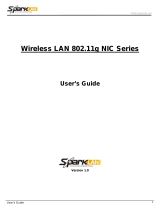 Spark Modem NIC Series User manual
Spark Modem NIC Series User manual
-
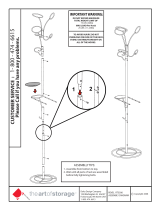 The Art of Storage RT5500 Installation guide
The Art of Storage RT5500 Installation guide
-
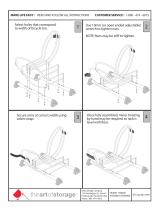 The Art of Storage RS8000W Operating instructions
The Art of Storage RS8000W Operating instructions
-
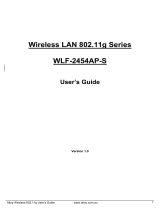 Alloy Computer Products WLF2454AP-S User manual
Alloy Computer Products WLF2454AP-S User manual
-
Philips CPWBS054CPWBS054 User manual
-
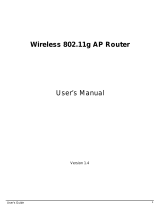 Link electronic 802.11g User manual
Link electronic 802.11g User manual
-
Trendnet TEW-411BRPPLUS Owner's manual




































